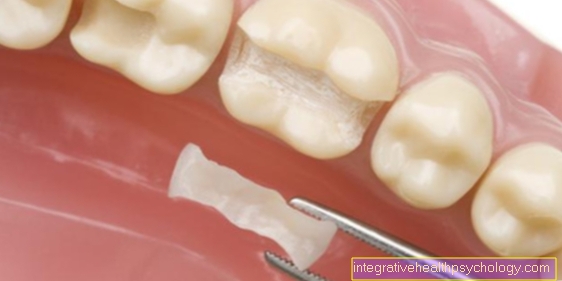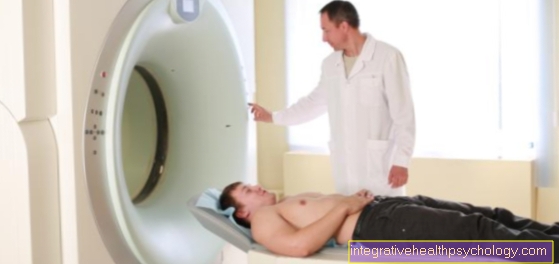School enrollment test
definition
The school enrollment test, sometimes also the enrollment examination (ESU) or school entry examination (SEU, S1), is a mandatory test by the health department for all children who are to start school in the coming year. This affects children around the age of 6.
The aim is to find out whether a child is already capable of school, or whether it needs specific support or further help.
The test is not identical to the last U examination (U9), which should have already taken place if possible. For this purpose, the test checks the social, cognitive and motor development status as well as the hearing and eyesight (screening) in a playful way.
In some cases and depending on the federal state, this also includes a general school medical examination, which may include checking the general physical condition, vaccination status and clarifying findings from previous examinations.
Read more on the subject at: school enrollment

Course of the enrollment test
Since the German education system is regulated by the respective federal states, the key dates, components and the exact procedure of the test differ from state to state. Due to different capacities and equipment, details in the process can also differ between districts or even cities.
In Baden-Württemberg e.g. the test is divided into two parts: in the penultimate year of kindergarten, the first test to identify special needs is carried out, while a few months before starting school, often only the state of health is examined.
In some places, a trial lesson is held at the school with the preschoolers afterwards.
As a rule, all parents of school-age children are invited in writing. For this purpose, both the communities and the kindergartens transmit the data required for this to the health department. The test is carried out in kindergartens, schools or sometimes directly in the health department either by specially trained educators or medical assistants from the health department. Occasionally, parts of the test are also carried out by speech therapists or psychologists.
The vaccination certificate and the yellow booklet should be taken with you to the test.
The parents often receive a questionnaire with the invitation, which the parents can usually fill out on a voluntary basis. Whether parents are allowed or should be present at the test is handled differently.
Are you interested in this topic? Then read our next article below: What should my child be able to do by the time they start school?
Which tasks are set in the test?
The tasks of the test do not test knowledge and are designed in such a way that they should be solvable for a school-age child of the appropriate age without preparation.
Arithmetic, reading and writing are usually not required. After all, these are skills that the child is taught in school. Sometimes an attempt is made to package the test in a kind of game in order to be able to experience the child in a relaxed and stress-free atmosphere.
To clarify the development of gross motor skills, the child is often asked to walk forwards and backwards in a line or to stand on one leg and hop. Fine motor skills are also often checked in connection with cognitive and language development.
Possible tasks are:
- Name or trace colors and simple shapes (triangle, square)
- Repeat words correctly (often also funny nonsense words)
- Improve incorrectly or incompletely pronounced words (e.g. Ele-ant)
- Clap syllables
- form the plurality of words
- Recognize objects in pictures or differences in two pictures
- create a picture according to a template or freely
- retelling a picture story
- Count to 10 or as far as possible
- Recognize quantities
- tell a story from everyday life
- name your own birthday or address
- Follow smaller multi-stage prompts
In addition, characteristics such as sociability, eagerness to learn and emotional stability are also considered.
Occasionally children are also asked to write their own name or to write all the letters of the alphabet that they already know. However, these are usually voluntary additions that are not included in the assessment.
Visual acuity can be shown both via the LEA test, in which the child is shown ever smaller, simple motifs, and via the E-hook test, in which the child has to say on which side as the image is getting smaller and smaller and randomly rotating the E is open.
Color vision is also tested using Ishihara tablets.
Hearing can be tested using the pilot test. Here the child has to point to the appropriate symbols after instructions that become quieter and quieter. Another possibility is the measurement via tympanometry, a method in which the mobility and the resulting reflectivity of the eardrum are measured.
Are you still wondering whether it might. can wait another year before starting school? Then read detailed information on this under: Is my child ready for school?
How long does the test take?
The duration of the test can also vary widely, but normally it should not last longer than an hour.
What are the consequences of the results?
The results of the school enrollment test are only a snapshot and can be falsified, for example, by nervousness or general listlessness of the respective child.
The aim is to find as many children as possible who have further educational needs. There are always a few children who are actually at a normal level of development. Therefore, an abnormal result is always followed by further diagnostics.
Especially with children who do not have to go to school yet, but are already allowed to do so, so-called optional children, there is occasional disagreement between parents, the health department and the school management about when to start school.
If no agreement can be found, the final decision lies with the school management.
Please also read: Learning problems





























